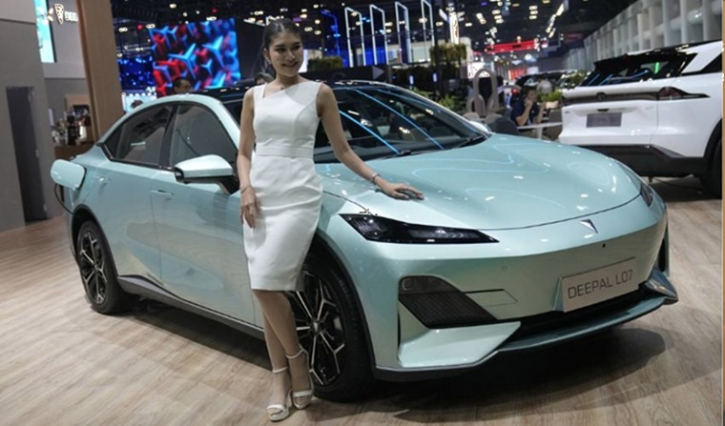How China’s new auto giants overtook GM, VW and Tesla

Published : 07:52 PM, 4 July 2025
In late 2023, the Chinese car company Chery made a last-minute decision to upgrade its Omoda 5 SUV for the European market. The car had been designed for China’s smooth roads, but it needed better suspension and steering for Europe’s bumpier streets.
Within just six weeks, Chery engineers redesigned the car's steering, brakes, tires, and more. Then they started shipping it to Europe.
One of Chery’s top engineers, Riccardo Tonelli, said this kind of speed is unheard of in European companies, where it might take over a year to make similar changes.
This shows how fast and flexible Chinese automakers have become. They now dominate the Chinese car market and are expanding quickly around the world.
One of the leaders is BYD, China's biggest automaker and a major electric vehicle (EV) company. Along with Chery, they are now serious threats to older global brands like GM, Volkswagen, and Tesla.
Why Are Chinese Car Companies Winning?
The biggest reason is speed. Chinese automakers can develop a brand-new car in about 18 months. Western brands often take five years or longer. This allows Chinese companies to release newer models faster and cheaper.
According to research firm AlixPartners, the average Chinese electric or hybrid car in the market is just 1.6 years old, while foreign-brand cars are around 5.4 years old.
This speed saves time and money. Chinese automakers:
- Work longer hours (six 12-hour days a week is common)
- Build most of their own parts instead of buying from suppliers
- Use artificial intelligence (AI) and digital simulations instead of long road tests
What’s Happening to Global Car Brands in China?
From 2020 to 2024, sales for foreign car brands like VW, Toyota, Honda, GM, and Nissan dropped sharply—from 9.4 million to 6.4 million vehicles. Meanwhile, the top five Chinese carmakers more than doubled their sales—from 4.6 million to 9.5 million.
To catch up, some foreign companies are now working with Chinese ones. For example:
- VW is working with Chinese EV company Xpeng
- Toyota is developing electric cars with BYD
At the 2025 Shanghai Auto Show, VW’s China chief said they want to become “as fast and competitive as a Chinese startup.”
From Copycats to Innovators
In the past, Chinese automakers copied foreign car designs. For example:
- Chery made cars that looked like Chevrolets
- BYD copied Toyota’s designs
But now, Chinese companies have created their own processes to build cars faster. Instead of making many test cars, they use AI simulations and update the car after it's launched—similar to how tech companies update software.
They accept small risks in quality to move fast.
It’s a Tough Battle in China
There are 169 car brands in China, but most make less than 0.1% of total sales. Many companies are losing money because they’ve built too many factories and now make more cars than they can sell.
For example, Chinese factories can produce 54 million cars a year, but only 27.5 million were made last year.
This has led to price wars, especially in electric vehicles. In May, BYD cut prices on 20 models. Its entry-level EV, the Seagull, now sells for $7,789. Some companies are even selling new cars as “used” to dump extra inventory.
The Export Push
To deal with losses at home, Chinese automakers are selling more cars overseas. In many markets, they sell their cars at the same price as global brands—but much higher than in China.
Consultant Phil Dunne said, “Traditional automakers can’t compete on price—the Chinese always win.” But in places like Europe, older brands still have better customer understanding and more experience.
Inside BYD’s Massive Machine
BYD’s headquarters in Shenzhen is like a small city with factories, offices, apartments, and schools for workers. It added 200,000 new employees in just a few months in 2024. BYD now has nearly 900,000 workers—more than Toyota and VW combined.
They build over 40 different models and update them constantly. Since Tesla released the Model Y in 2020, BYD has launched over 139 new or refreshed vehicles.
BYD’s CEO, Wang Chuanfu, is known for his intense focus. He eats simple meals, wears company uniforms, and often drives himself to work. One investor said, “His life is all about BYD—nothing else.”
BYD also makes most of its own parts. For example, 75% of the parts in the BYD Seal sedan are made in-house. For comparison:
- Tesla Model 3: 46% in-house parts
- VW ID.3: 35% in-house parts
This gives BYD more control and helps them move faster.
BYD vs. Toyota: Different Worlds
When Toyota worked with BYD to build a joint EV called the bZ3, their engineers were shocked by BYD’s fast and loose style.
Toyota usually spends four years developing a car, builds six prototypes, and does tens of thousands of miles in testing. BYD skips much of that, updating the car after launch.
Toyota engineers respected BYD’s speed—but worried about long-term reliability.
Will BYD Overtake Toyota?
BYD wants to sell half of its cars outside China by 2030. But this might be tough since Chinese cars are mostly banned in the U.S. and other markets may also block them.
Speed is Everything
Another rising Chinese brand, Zeekr (part of Geely), is using flexible production and global teamwork to move faster. For example, engineers in China and Sweden work round-the-clock by handing off work across time zones.
Zeekr also uses AI and old design libraries to speed up development.
Western car brands like GM’s Buick and Volkswagen are trying to catch up, but still face big challenges. One former VW engineer said it once took 75,000 kilometers of testing just to change the color of trees on a navigation map.
“This is why traditional carmakers can’t do speed,” he said.
Still, Chinese cars are passing top safety tests in Europe, showing that fast development doesn’t always mean poor quality.
Chery: The Silent Giant
Chery may not be well-known in the West, but it’s already China’s top exporter. It sells in over 100 countries and plans to build factories in Europe, including one in Spain.
Chery makes all types of cars: gasoline, hybrid, and electric. Its Omoda line includes gas, EV, and plug-in hybrid models.
If one model doesn’t sell, Chery can replace it in under two years.
“If everyone hates it, we just change it,” said one executive.

.png)
.png)






